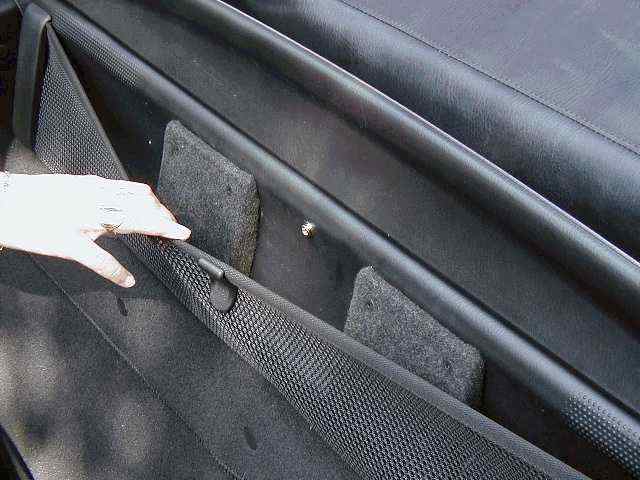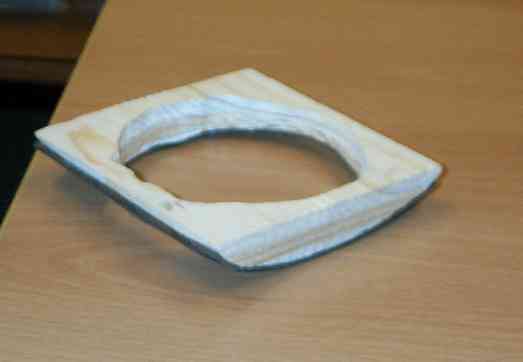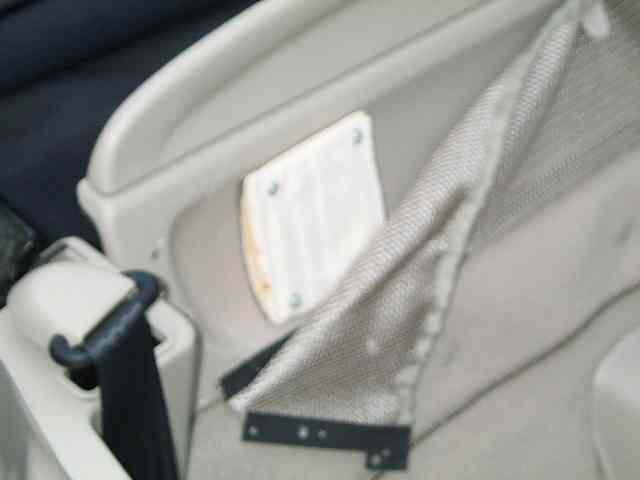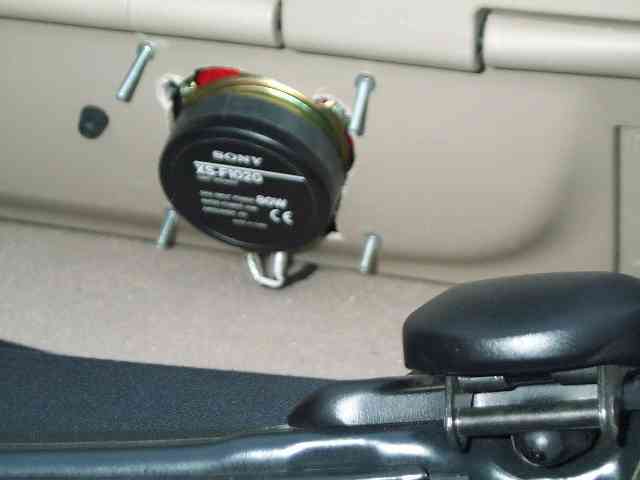
Shortly after I installed my Pioneer DEH-P3000R CD/radio in my MX-5, I made a surprising discovery. The car has almost perfect suppression of radio-frequency interference, which means that I can receive BBC Radio 4 on 198 KHz long wave from the UK, nearly 700 kilometers away, even with the engine running (normally it's possible to get Radio 4 only when the engine is off). I immediately began to look forward to long drives listening to the cricket commentary !
After driving around for a few weeks with the top down, I found that at speeds over about 110 km/h, it was sometimes hard to make out spoken voices. Music is fine up to about 140 km/h, with the bass thumping down my left leg. So I set out to find a way to install speakers behind by head.
It appears that Miatas delivered in North America usually come with speakers in the headrests, or at least with a space to wire them in. In Europe, this isn't available, probably because the headrests are detachable from the seats. Some miata.net forum participants have installed speakers in the rear deck, but I didn't like this for a few reasons:
I decided to look at the possibility of installing a pair of 10cm (4 inch) speakers in the windblocker. My idea was that this "only" involves cutting plastic, and that even if I gave up on the idea, any scars would be hidden by the netting. (And a new windblocker isn't ruinously expensive, if the worst comes to the worst.)
By now you will have detected that I'm not a major car hi-fi buff or handyman - just a proud, slightly nervous MX-5 owner wanting to marginally improve a small aspect of the sound system. I found the discussion on miata.net's audio forum a little overpowering - all subwoofer this, baffle that. (As this article progresses, audiophiles will notice that both my implementation, and the words I use to describe it, are somewhat audio-awareness-challenged.)
Then I was contacted by François, a fellow French resident who showed me his windblocker speaker setup:

He assured me that the sound was great, so I decided to copy his idea.
First I splashed out about 45 Euros on a pair of Sony XS-F1020 twin-cone 10 cm speakers. I could have bought cheaper, but I like the twin-cone idea and the Sonys were also not too deep (44mm) compared to some other speakers.
Next, I set about building the supports. The idea is to have a flat surface on which to mount the speakers, with the other side curved to fit snugly against the windblocker. (If you've ever wondered why the inside surface of the windblocker curves like that, put the seat right back and recline it as far back as it will go - it fits into the windblocker's curve !) I took two pieces of pine ("Douglas", according to my neighbor who gave them to me - he sells wood panels for a living, so I won't argue), each 21mm thick and about 11cm square. (Next time: I'll use 12cm square and trim it afterwards if necessary. At one or two points in the process, the pieces I was using seemed rather flimsy with a big hole in them.)
Using a bandsaw, I made a hole more or less the size of the speaker magnets (next time: I'll make it a centimeter bigger all around) and filed them down with my trusty cordless Dremel until the speakers fitted through. As an extra luxury (well, you only do this once, so might as well make at least an attempt at a decent job), I also removed an extra 2mm from a further 5mm radius around the edge of the hole, so that the last curved part of the speaker rim would fit in and the flanges which take the screws were flush against the wood.
Now to make the supports fit against the windblocker. I did the first one entirely with the Dremel (pausing twice to recharge it !) since the amount of wood left didn't seem to be too large, and also because it let me pause frequently to check how it was coming along. Once that fitted snugly, I did the second one mainly on a sanding disk attached to a power drill, which went a lot quicker.
As an extra touch, I took some off-cuts of acoustic insulation material (which I had lying around from insulating the trunk of the car) and stuck that on the curved side. My idea was to reduce the vibrations being transmitted to the windblocker. I don't know why I thought this might be a good idea, or even work, but it seemed obvious (see note above about my audio-awareness). Here's one of the supports:

Now for the moment of truth. I'm going to have to take a drill and a saw to part of my car, even if it is a readily-available and (by Mazda standards) not too expensive part. I removed the windblocker (next time: I'll do this before I make the wooden supports, as it would have meant getting less sawdust in the car when continually checking the fit), which is easy: just remove the two ordinary screws and the two pop-retainers (for the top cover) and lift it out. (Note for when you put it back in: the pop-retainers go on the bottom.)
Next, I had to get the net out of the way. I started by levering one of the eight or so black buttons which hold it on at the bottom along the seamed edge. I'd hoped the button would pop out of the windblocker, but it didn't - instead the net unbuttoned itself from it. This was clearly not good. I shoe-horned the net back onto the button (five minutes, some profanity) and decided to look what was under the plastic covers at the side. I inserted a large flat-bladed screwdriver at the outside edge and levered one cover gingerly upwards. It looked promising, so I levered a bit less gingerly. This is one of those nerve-racking moments when you know something will give, and it's just a question of whether you'll be able to get it back on again if the retaining lugs shatter. Well, I got away with. Two pops (near the top and near the bottom) and the outside of the plastic cover came away. A little bending and it came away completely, revealing three screws holding a black plastic clip. Removed those, off with the clip, and the net fell forwards. Same thing the other side and the net was free.
Keeping the windblocker horizontal, I rechecked the seating of the speaker supports to get them exactly flush, and marked the outline of the speaker holes with a soft pencil. I'd already decided to put them directly behind the headrests, which means on the outside of the little rib in the windblocker, compared to the setup François used where they are close together. I thought this would give me better stereo separation, once again displaying my mastery of randomly selected audio buzzwords. One disadvantage is that it makes you think twice about using maximum seat recline and maximum legroom, as the back of the seat will lean quite firmly on the speaker. (It helps to choose where you want the speakers to go before you make the supports, as the profile of the windblocker varies slightly along its length.)
OK, here we go... 8 mm pilot hole... bandsaw ready... action...

Actually it wasn't too bad. The plastic seems very hard if you try to use something like a Stanley cutter on it, but it can be sawn through without too much difficulty. The saw doesn't jump around or anything like that. There are two layers of plastic with a couple of millimeters between them. The surface of the plastic is quite sensitive to knocks, however, and scratches easily. After making a couple of scratches with the guide plate of the saw (used when cutting along straight lines), I removed it and the second hole had almost no marks around it. (Don't worry too much about the scratches as the net will cover a lot of blemishes when you put it back.) A rat-tailed file helps to widen the holes around the non-round bits of the speakers.
At this point I was lucky enough to find a good material to cover the speakers. I used some of that unpleasant furry wallpaper that you find in the corridors of French hotels. It was more cream than beige in color, but I could see that once behind the net it would be good enough. The backing paper soaked off in warm water and I had a nice, thin, carpet-type layer to put on the front of the speakers. I could have wrapped it all the way round like François did, but since (a) the wood is a similar color to the car's interior and (b) I didn't want to get between the sound insulating material and the windblocker, I decided to just barely cover the front with an 11cm square. I drilled four 4mm holes in each support (3.25 mm or 1/8 inch bolts are recommended by Sony, but I didn't have them handy). Before putting the speakers on the support, I put the supports in place and marked the drilling points for the windblocker with a 3mm awl.
Next, I mounted the wallpaper material and the speakers in the support with 4 x 50mm bolts and a washer. Drilled the 4mm holes in the windblocker (try not to mess up here; you only get one chance) and was amazed to find that everything lined up ! I worked the bolts through the holes (some leaning required, and a powered screwdriver helped), and threaded and tightened the nuts on the other side. After putting the windblocker back, here's what it looked like (front and rear; slightly out-of-focus pictures, I'm afraid):


(I've ordered some foam baffles to make the rear of the speaker look neater, and maybe get slightly better sound. At that point I'll know exactly how much to trim from those bolts.)
All that remained was to connect the wires. I left this to a local car audio guy, as I don't have the tools to get the radio out. He made a very nice job, running the wires under the central console and the carpet. They emerge just behind each speaker for a totally discrete appearance. Once he'd finished, I put back the bits of plastic trim to keep the net in place, and now you have to know the speakers are there to notice them.
And now... the road test !
Well, I can report that the overall effect is excellent. The source of the sound is no longer "right in front" (at least I have tweeters; with just the stock door speakers I imagine everything sounds like it's coming from your feet), but instead, the source of the sound seems to be centered just above the ashtray. To my surprise, the best fader position is close to zero (neutral), although for speech a slight emphasis to the rear (maybe -2 out of 15) and for loud rock, ditto to the front (+2 or so), can sound slightly better if you listen hard enough.
| Back to the Garage | 18 September, 2000 |